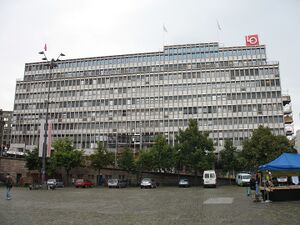Difference between revisions of "Norwegian Confederation of Trade Unions"
(trade union) |
m (subgroup) |
||
| (3 intermediate revisions by the same user not shown) | |||
| Line 5: | Line 5: | ||
|logo=LO-emblem.png | |logo=LO-emblem.png | ||
|start=1899 | |start=1899 | ||
| + | |subgroups=Norwegian Seafarers' Union | ||
|description= The largest and most influential umbrella organization of labour unions in Norway, closely connected to the [[Norwegian Labour Party|Labour Party]]. | |description= The largest and most influential umbrella organization of labour unions in Norway, closely connected to the [[Norwegian Labour Party|Labour Party]]. | ||
|headquarters=Oslo,Norway | |headquarters=Oslo,Norway | ||
| Line 17: | Line 18: | ||
==Own surveillance central== | ==Own surveillance central== | ||
| − | [[image:Folkets Hus Youngstorget.JPG|thumb|left|''Folkets Hus'' | + | [[image:Folkets Hus Youngstorget.JPG|thumb|left|''Folkets Hus'' in Oslo]] |
| − | The union had its own wiretapping center, located on the 9th floor of the union's headquarters | + | The union had its own wiretapping center, located on the 9th floor of the union's headquarters ''Folkets Hus'' in Oslo during the [[Cold War]]. |
| − | The | + | The mission of the wiretapping was to register and control both potential security risks and political opponents. The building was hired out as a meeting locale to most left-wing organizations in Norway, including the several [[Communists]] ones. From room 906 at LO's headquarters in Oslo, a few select employees could choose any conference hall or meeting room in the house and listen in headphones to what was said there. The tapes that were recorded were passed on to the surveillance services, primarily the military [[Norwegian Intelligence Service]] and the police [[Norwegian Police Security Service|POT]], which made transcripts<ref>Ronald Bye, Finn Sjue ''De visste alt'' page 10</ref>. Copies of these were distributed to selected persons within the Labor Party, LO and the intelligence services. |
| − | The surveillance was revealed by [[Ronald Bye]], who himself for a time was main | + | The surveillance was revealed by [[Ronald Bye]], who himself for a time was the main operative in the bugging. According to Bye, [[Paul Engstad sr.]] was the main organizer. The decision to install the was made by NCTU Chairman [[Konrad Nordahl]] and the first main operative [[Arne Hjelm Nilsen]].<ref>Ronald Bye, Finn Sjue ''De visste alt''</ref> The room originally contained a register of 6000 people of interest, which was burned by Bye in [[1969]]. <ref>Ronald Bye, Finn Sjue ''De visste alt'' page 12</ref> |
| + | |||
| + | [[Arne Kokkvoll]], former head of the Labor Movement's Archive Section, said the system was nationwide: "It was not just Folkets Hus in Oslo that was intercepted. The wiretapping was set in a nationwide system, and I firmly believe that Folkets Hus were also monitored in other places in the country"..."I am absolutely convinced that the wiretapping was not just limited to Folkets Hus in Oslo. Especially in North Troms and [[Finnmark]], Folkets Hus was bugged, and this has also happened elsewhere in the country. In [[Bergen]], it has been known for several years that Folkets Hus in the city was intercepted."<ref>Akershus Arbeiderblad 26 November 1993</ref> | ||
| + | |||
| + | Ronald Bye says he was present when microphones were installed in Kokkvoll's office in [[1968]].<ref>Akershus Arbeiderblad 26 November 1993</ref> | ||
| + | |||
| + | Kokkvold also said that he was aware of several [[suicides]] as a result of ongoing [[psychological warfare]], surveillance and terror. He also knew about alleged suicides among people in the [[Norwegian Intelligence Service]] who had talked about going public with what they knew about illegalities.<ref>Quoted in ''Ramm/Setsaas ''[[Grogate]]'', page 352</ref> | ||
| + | |||
| + | The system was phased out by the early 1980s, as new technology for [[room surveillance]] through telephones was introduced. <ref>Ramm/Setsaas ''[[Grogate]]'' (in Norwegian) page 364</ref> Due to technical limitations, this led to a spate of people telling how their own conversations were played back to them when they lifted the receiver again shortly after a finished call. This system was again presumably replaced with untraceable electronic interception in the [[1990s]]. | ||
==Stay behind== | ==Stay behind== | ||
After [[World War 2]] the Labour movement conducted an extensive surveillance and registering of its communist rivals, and were the main drivers in getting communist labour unionists fired from their workplaces. [[Rolf Gerhardsen]], brother of Prime Minister [[Einar Gerhardsen]], led this work, under cover of his main job as editor-in-chief of ''Arbeiderbladet''. | After [[World War 2]] the Labour movement conducted an extensive surveillance and registering of its communist rivals, and were the main drivers in getting communist labour unionists fired from their workplaces. [[Rolf Gerhardsen]], brother of Prime Minister [[Einar Gerhardsen]], led this work, under cover of his main job as editor-in-chief of ''Arbeiderbladet''. | ||
| − | The Labour | + | The Labour party, including NCTU, was the central part of the [[Norway/Stay Behind|stay behind system]], of which little is known. |
Latest revision as of 05:47, 22 December 2023
 | |
| Formation | 1899 |
| Headquarters | Oslo, Norway |
| Subgroups | Norwegian Seafarers' Union |
| Interest of | Norwegian People's Aid |
| The largest and most influential umbrella organization of labour unions in Norway, closely connected to the Labour Party. | |
The Norwegian Confederation of Trade Unions (Norwegian: Landsorganisasjonen i Norge, LO) is a national trade union center, decidedly the largest most influential umbrella organization of labour unions in Norway. The 21 national unions affiliated to the LO have almost 1,000,000 members of a Norwegian population of 5 million. The majority of affiliated unions organizes traditional blue collar workers, but the largest affiliate is the Norwegian Union of Municipal and General Employees which makes up more than a third of all members.[1]
Ever since the first years in 1899, LO had very strong ties to the Labour Party, among other things through collective membership. According to the two organizations, the close co-operation between LO and the Labour Party is itself a co-operation between independent organizations with overlapping interests. The Labour Party also traditionally elects LO's top shop stewards to its central commitee.
Contents
Own surveillance central
The union had its own wiretapping center, located on the 9th floor of the union's headquarters Folkets Hus in Oslo during the Cold War.
The mission of the wiretapping was to register and control both potential security risks and political opponents. The building was hired out as a meeting locale to most left-wing organizations in Norway, including the several Communists ones. From room 906 at LO's headquarters in Oslo, a few select employees could choose any conference hall or meeting room in the house and listen in headphones to what was said there. The tapes that were recorded were passed on to the surveillance services, primarily the military Norwegian Intelligence Service and the police POT, which made transcripts[2]. Copies of these were distributed to selected persons within the Labor Party, LO and the intelligence services.
The surveillance was revealed by Ronald Bye, who himself for a time was the main operative in the bugging. According to Bye, Paul Engstad sr. was the main organizer. The decision to install the was made by NCTU Chairman Konrad Nordahl and the first main operative Arne Hjelm Nilsen.[3] The room originally contained a register of 6000 people of interest, which was burned by Bye in 1969. [4]
Arne Kokkvoll, former head of the Labor Movement's Archive Section, said the system was nationwide: "It was not just Folkets Hus in Oslo that was intercepted. The wiretapping was set in a nationwide system, and I firmly believe that Folkets Hus were also monitored in other places in the country"..."I am absolutely convinced that the wiretapping was not just limited to Folkets Hus in Oslo. Especially in North Troms and Finnmark, Folkets Hus was bugged, and this has also happened elsewhere in the country. In Bergen, it has been known for several years that Folkets Hus in the city was intercepted."[5]
Ronald Bye says he was present when microphones were installed in Kokkvoll's office in 1968.[6]
Kokkvold also said that he was aware of several suicides as a result of ongoing psychological warfare, surveillance and terror. He also knew about alleged suicides among people in the Norwegian Intelligence Service who had talked about going public with what they knew about illegalities.[7]
The system was phased out by the early 1980s, as new technology for room surveillance through telephones was introduced. [8] Due to technical limitations, this led to a spate of people telling how their own conversations were played back to them when they lifted the receiver again shortly after a finished call. This system was again presumably replaced with untraceable electronic interception in the 1990s.
Stay behind
After World War 2 the Labour movement conducted an extensive surveillance and registering of its communist rivals, and were the main drivers in getting communist labour unionists fired from their workplaces. Rolf Gerhardsen, brother of Prime Minister Einar Gerhardsen, led this work, under cover of his main job as editor-in-chief of Arbeiderbladet.
The Labour party, including NCTU, was the central part of the stay behind system, of which little is known.
Related Quotation
| Page | Quote | Author | Date |
|---|---|---|---|
| Norwegian Labour Party | “The Labour Party is no damn Sunday school.” | Haakon Lie | 1975 |
Employee on Wikispooks
| Employee | Job | Appointed | End |
|---|---|---|---|
| Kaare Sandegren | Head of the international department | 1971 | 1994 |
References
- ↑ Ole Storeng (3 May 2013): Lederskifte gir ingen revolusjon Aftenposten, retrieved 6 May 2013
- ↑ Ronald Bye, Finn Sjue De visste alt page 10
- ↑ Ronald Bye, Finn Sjue De visste alt
- ↑ Ronald Bye, Finn Sjue De visste alt page 12
- ↑ Akershus Arbeiderblad 26 November 1993
- ↑ Akershus Arbeiderblad 26 November 1993
- ↑ Quoted in Ramm/Setsaas Grogate, page 352
- ↑ Ramm/Setsaas Grogate (in Norwegian) page 364
